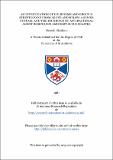An investigation of coliforms and group D streptococci from above and below a sewer outfall and the incidence of antibacterial agent resistance amongst such isolates
Abstract
The numbers and species of coliforms and group D streptococci isolated from water samples taken from above and below a sewer outfall by the membrane filtration method were compared. In addition, group D streptococci obtained from a variety of clinical sources were also speciated. The numbers of coliforms below the outfall were shown to increase by a factor of 36, whereas group D streptococci below increased by a factor of 150, as compared with the counts above. Speciation of the isolates indicated that Escherichia coli and Enterobacter species were the most common Coliform species from both sampling sites. Streptococcus faecalis strains were the most prevalent group D streptococci from below the outfall and from clinical sources whereas Streptococcus faecium var casseliflavus strains predominated above. The determination of the Faecal Coliform (FC) to Faecal Streptococci (FS) ratios indicated that pollution in both sites was mainly from human origin. The "in vitro" susceptibility of all isolates to antibacterial agents was tested by the agar dilution method. Chloramphenicol and trimethoprim were most active against all coliform isolates, followed by tetracycline, cephalexin, sulphamethoxazole, ampicillin and streptomycin in that order. Drug resistant coliforms were encountered from both sampling sites, and a significant number of multiple drug-resistant coliforms, particularly E. coli were detected. Both E. coli and Enterobacter species from below the outfall showed a statistically significant increase in resistance to ampicillin, and E. coli strains from below the outfall also showed a statistically significant increase in resistance to stilphamethoxazole as compared with isolates from above. Ampicillin and penicillin were the most active drugs against all species of group D streptococci. Of the two aminoglycosides tested gentamicin was more active than streptomycin. Erythromycin was highly active against more than half of the strains. Tetracycline resistance was most frequent followed by Streptomycin. Streptococcus bovis and Streptococcus equinus strains were, in general, more susceptible to the drugs tested than were the other species. Streptococcus faecium strains displayed the widest range of resistance to the drugs tested. No multiple-drug-resistant group D streptococci species were encountered above the outfall, but a few isolates from below and from clinical sources were multiple-drug-resistant. Statistical analysis showed no significant increase in drug resistance between isolates from above as compared with isolates from below. Conjugation studies indicated that for both groups of organisms, the drug resistance markers were transferable. Curing experiments with acridine orange showed a very low capacity of the agent to eliminate the R-factors from these bacteria.
Type
Thesis, PhD Doctor of Philosophy
Collections
Items in the St Andrews Research Repository are protected by copyright, with all rights reserved, unless otherwise indicated.

